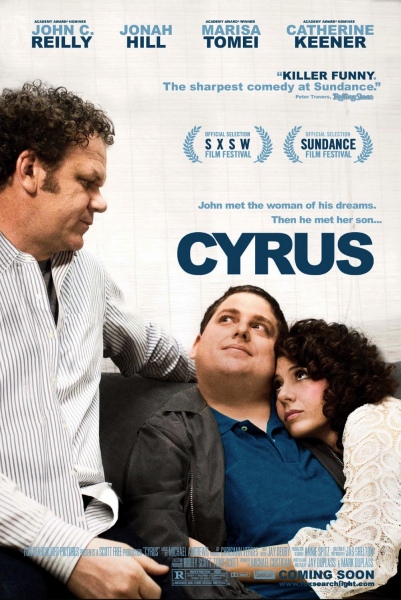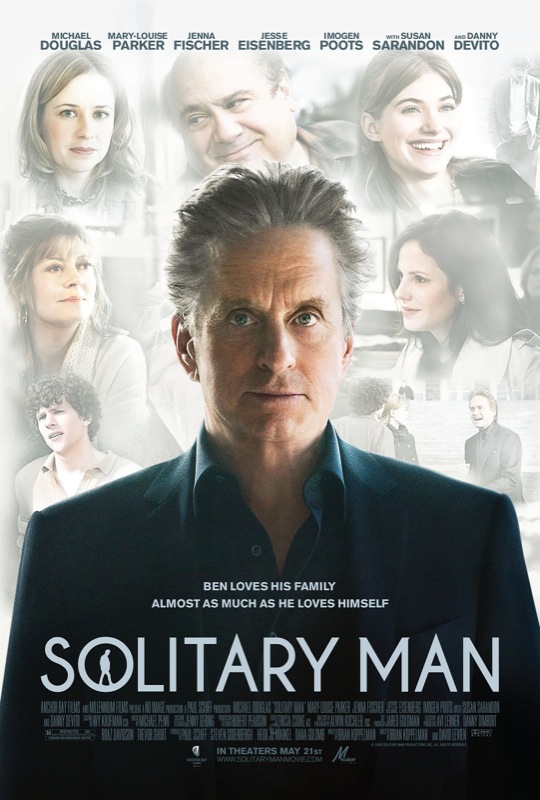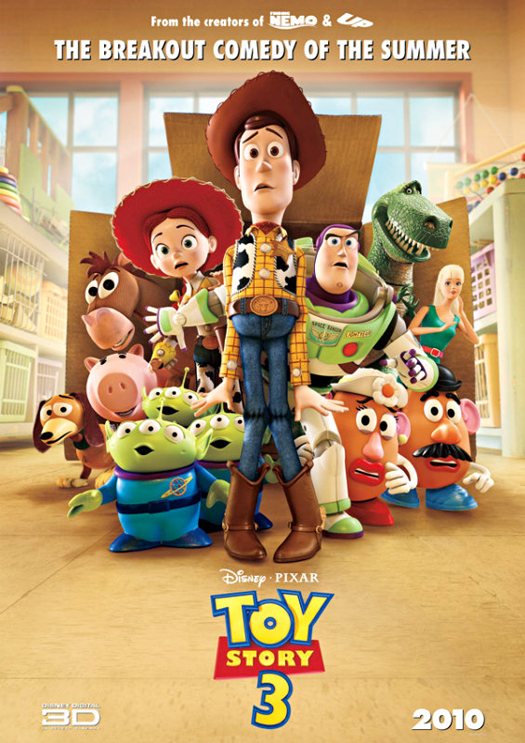TOP 7 Movies So Far in 2010 ... another opinion
We start the Top 7. You finish the Top 10.
Not bad, 2010. But not super, either. Of course this year has seen the release of a few gems, but most of them have been in limited release. And while I enjoy the unique company of movies like Greenberg or Solitary Man, I am still hoping for the big Hollywood productions that will blow me out of the water, instead of leaving me stranded on Mostly Mediocre Island where Toy Story 3 seems to be my only lifeboat. Row on, mainstream movies. I believe in you, and can't wait to see what you've got next. I'm looking at you Inception. If Christopher Nolan can't do it, who can?
For now, here are the Top 7 movies released in 2010 so far. All films were released before July 1 and all of these come with a hearty recommendation. For the movies on this list that are still in theaters, I apologize in this case if your art houses are much harder to get to than your multiplexes.
click here for Jeff Bayer's TOP 7 Films So Far in 2010
 7. Cyrus
7. Cyrus
Recap: A divorcee’s (Reilly) relationship with his new girlfriend (Tomei) is put on the rocks by his interactions with her weirdo man-child son named Cyrus. Reason: Cyrus is a movie that recognizes human interactions can be more awkward than than they are smooth, and while it may star two schlubs known for goofing off in Judd Apatow-like productions, their social clumsiness is not focused with the straight-shot intention of being funny. A movie like this only has the marketing potential to be another fraternal fight. The achieved realism protects this story from becoming simple entertainment, and thus the authentic weirdos in Cyrus help in making this an odd specialty.
6. Casino Jack and the United States of Money
Recap: A documentary about lobbyist Jack Abramoff and the many scams he took part in while hobnobbing with the top members of Congress. From the director of Enron: The Smartest Guys in the Room. Reason: Only attacking our “United States of Money” at the end of the documentary, this portrait of a compelling villain says that we the people can be the James Bonds against folks like Abramoff, as shown through the consistent usage of Jimmy Stewart’s performance in Mr. Smith Goes To Washington. Abramoff’s many intricate shenanigans, which range from exploiting Native American tribes for campaign funding to controlling an entire island in the Marianas, are all told in thorough detail in director Alex Gibney’s fast-moving and always fascinating documentary. It’s slightly discouraging when Gibney seems to skip over the names of involved Democrats, but with the anger fuming from his organized documentary, Gibney makes it equally fascinating and frustrating to watch a very rich “con-man” find new ways to reinvent the wheel of evil.
5. Greenberg
Recap: Freshly released from a mental hospital, almost 40-year-old Roger Greenberg (Stiller) refuses to accept his age, and attempts to live a carefree existence. While staying at his brother’s place, he falls for the housekeeper (Gerwig), a young woman who is “out of college for as long as she was in.” Reason: It took a story of youthfulness to mature director Noah Baumbach. In the past his characters and their stories have been too dysfunctional (Squid and the Whale) or piercing (Margot at the Wedding) to resemble the reality that all of his films strive for. Greenberg has things more under control, with a new batch of more likeable characters floating around a contained message of adulthood’s required maturity. Stiller can sometimes be frustrating with his overly bratty character, but nonetheless works in creating a compelling persona that should speak to those who may not laugh with the film as much as others. Baumbach is one of a few modern filmmakers that truly understands just how awkward life can be. Finally, he shows that his awkwardness can be somewhat refreshing, not depressing.
4. The Ghost Writer
Recap: An author (McGregor) who is hired to write the memoirs of a controversial politician (Brosnan) finds himself in the middle of the chaos when investigating the prime minister’s true motivations for being in politics. Reason: The Ghost Writer is a great example of what a taut thriller can be: Odd pieces of a puzzle clashing together to create a heart pounding tension, while the big picture is simultaneously understood by the lead character and his/her audience. This thick movie carefully places its twists on a well-plotted track as it chugs along on brain fuel that is rare to mainstream movies of today. Admirably, it maintains a political edge that’s relevant to current climates, along with some of the later chapters of director Polanski’s own life. From top to bottom the performances are engrossing, particularly Pierce Brosnan in one of his more commendable roles. Not a film to slack on the most important aspects of what makes a great film, The Ghost Writer has a fantastic conclusion that unties every purposeful knot. The entire package is bound tightly, the way a good book should be.
3. The Art of the Steal
Recap: In 1922, a man by the name of Albert Barnes opened up a small art museum in a Pennsylvania suburb, putting on display his personal collection, which contained 800 paintings, in total thought to be worth around six billion dollars. This documentary tells the story of “the worst art theft since World War II,” as art purists fight to keep the legendary works out of museums more focused on tourism than presentation. Reason: Through many back-stabbings in a frustrating turn of events, the compelling story (which can only be sad but true) raises head-scratching issues about art’s value both economically and emotionally. With their beloved creations carted around to worldwide self-serving exhibitions by corporate pimps, have artists like Matisse or Monet become victims of beyond the grave prostitution? Wonderfully, The Art of the Steal tells one of the most complicated stories of true art thievery, and yet still has the gusto to bravely call out the crooks who only see the color green when examining a painting by Seurat or Van Gogh.
 2. Solitary Man
2. Solitary Man
Recap: After surviving an almost fatal heart condition, smooth-talking car salesman Ben Kalmen (Douglas) tarnished his relationships with all of those who were close to him. This is the story of him being convinced to try to make things right again. Reason: The title track “Solitary Man” is only heard once, but it becomes apparent that the heart of that song has been referenced as inspiration throughout the script’s entire creation. As he leads us through his own saga of solitude, Douglas’ charisma earns a special ownership on this kind of character we may have seen before (Up In The Air). Douglas is especially compelling to watch whenever he puts himself into and (tries to talk to his way out of) a plethora of confrontational doghouses, often due to his ways of being a “rich a**.” When doing this, he’s bouncing around a cast of welcome familiar faces that add their support in keeping this man’s story of avoiding relationship roots high above normal ground.
 1. Toy Story 3
1. Toy Story 3
Recap: With their 17-year-old owner Andy moving off to college, the toys are brought to a daycare in hopes of finding new adventures and friends. This second sequel is for any human being who has a shard of their childhood still remaining in their souls. It’s fair to say that if you never loved anything when you were a boy or girl that Toy Story 3 may not be your immediate source of happiness. But for everyone else on the planet, there’s no point in robbing your heart of this universally pleasing experience by missing it. If it’s any indication that this movie has no age-limit, the seasoned critics were laughing more boisterously than the army of children at my screening. Reason: With Toy Story 3, not only do Pixar succeed in bringing toys to life in the ways that only witches could dream of, but their flowing creativity is channeled towards making them brilliant, heartfelt creations that appear more human than most of the billboard-friendly faces we see weekly at the cinema. Like real human beings, these toys never collect emotional dust, nor can they resign to a one-color simplicity. It is only then fitting, as this trilogy draws to a close with a sweet but “transitional” note, that we feel the authentic ache in our heart, the chill down our spine, or the tear down our eye. We have loved these toys, or these clear mirrors of our youthfulness, as if they were our own.